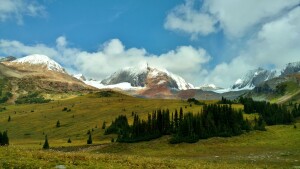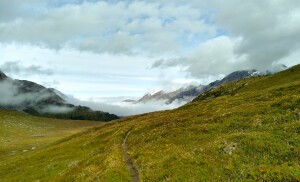The Great Divide Trail (GDT) is unique. It is wild! It is rugged! It is wilderness! It is pristine! It is beautiful! If it wasn’t, it wouldn’t be the GDT. Let’s keep it that way – it is unique. It travels through many areas that are particularly sensitive to overuse or in some cases, in areas that are managed as low use to secure habitat for certain species. And so requires trail camp permits that protect the trail and its environment by limiting the number of individuals at any given site on any given day, thus controlling the number of individuals in a given backcountry area of the National and Provincial Parks. These trail camp permits are required in some places, not all places. And of these permit-requiring places, some but not all, are popular places. It takes a bit of effort to get permits for these popular places, but definitely is not impossible. It wouldn’t be the GDT without these Parks permits…. BECAUSE they are one of the reasons the GDT is still wild! and rugged! and wilderness! and pristine! and beautiful! Let’s keep it that way and put in the effort to get those permits (this effort is nothing compared to the effort to hike the GDT). Besides, the permits are part of the GDT experience; without them, one doesn’t truly hike the GDT.
Permit Importance
How do permits ensure the GDT stays wild, rugged, wilderness, pristine, and beautiful?
Permits prevent overuse and overcrowding. The available number of permits per night, at each trail camp, is limited. Thus, the number of people on the trail is limited and spread out. These limits are a reflection of what the facilities can handle and environmental impact considerations. Minimal environmental impact and wildlife preservation are very important priorities of the Parks management, and needless to say, are necessary to preserve the wild, rugged, wilderness, pristine, and beautiful nature of the GDT. Without these limits, the GDT would not be the GDT, it would degrade into just another long trail where one would see far too many people or worse, result in closures of sections of the GDT eliminating the contiguous nature of the trail. Let’s hope this never happens.
Permits limit high impact human activity to small designated areas – the trail camps. Even with quotas/limits to the number of hikers, hikers still have high impact human “activities” mostly camping activities such as cooking, clean-up, waste disposal, storage, tents, campfires, etc., that are not part of the natural wilderness order. Again, for minimal environmental impact, fragile vegetation, and wildlife considerations, it is important to keep these high impact human camping activities in designated spots – the trail camps. Hikers can do all their camping activities that typically scare animals, or habituate animals to humans, disturb the natural vegetation, etc., in small, widely scattered locations – the trail camps, that also have facilities (i.e. toilets, bear lockers/hangs, food areas, etc.) to minimize the environmental impact and animal disruption and habituation to humans. An example – one caribou herd has already been extirpated in the southern half of Jasper National Park, and Parks Canada is trying their best to make sure the other two small caribou herds here are not lost too. These environmental, wildlife, and vegetation considerations, are big reasons why “stealth” camping is one of the most harmful things a person can do in these popular Parks.
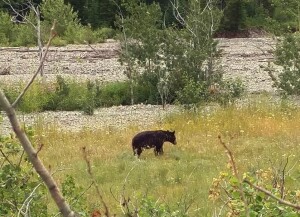 The animals live here. Humans are just guests.
The animals live here. Humans are just guests.
Permits justify and support Parks maintenance of trails, bridges, trail camps, signage, and so forth. As anyone who has hiked significant portions of the GDT knows, there are stretches of easy-to-follow, well maintained trail, with good bridges over tough water crossings. And there are stretches that are overgrown, and/or hard to follow, and/or have tough fords, etc. Parks maintenance crews (along with their partners such as the GDTA, Jasper Trails Alliance, etc.) are the ones who maintain the good sections of trail in the Parks, and the ones who oversee/manage this maintenance. Permits help make it worthwhile to Parks to do this trail maintenance that GDT hikers so appreciate and benefit from, especially after enduring some of the unmaintained sections of the GDT.
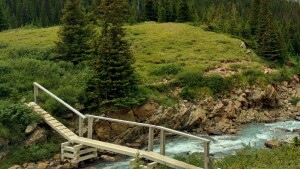 Nice bridge. Thank you, Parks Canada.
Nice bridge. Thank you, Parks Canada.
Parks require permits. It is of paramount importance for GDT hikers to get these permits to ensure GDT support from Parks Canada and a good working relationship with Parks Canada. Parks Canada has a mission to preserve the wildlife, environment, ecology, ecosystems – a noble mission that results in what the GDT is – wild, rugged, pristine, beautiful, wilderness – and permits are part of this mission implementation strategy. Parks Canada also has management objectives to maintain trails, signage, bridges, trail camps, etc., – all of which benefit GDT hikers, and permits help support and justify these objectives.
Improvements to challenging GDT stretches within the national parks are possibilities with a good Parks Canada-GDTA relationship. Parks Canada is the GDT’s friend and host of major stretches of the GDT (more than 45% of the GDT is within national parks). Getting Parks Canada-required permits, shows Parks Canada that one honours their rules, just as one would follow the rules of any other host/hostess or good friend. Besides, if one doesn’t, it endangers the GDT’s existence. A good working relationship with Parks Canada is necessary for the GDT to go forward into the future, to be there for you, your fellow hikers, your children, your grandchildren, and so on. In the words of Parks Canada, here is their noble mission: “The Parks Canada mandate and charter“.
Permit Pragmatism
Obviously, to get permits, one must have a daily itinerary that identifies the desired camping spot for each night. If the entire task of planning at such a detailed, daily level seems daunting, the GDTA website has plenty of resources to assist. A good starting place are the GDTA’s Trip Planning Resources. Another handy, quick reference is “A Step-by-Step Guide to Planning Your GDT Hike“ – a Winter 2021 Pathfinder Newsletter article.
Fortunately, most GDT hikers put in the effort and get their permits. But as on any long hike, things don’t always adhere to schedule, plans may not be 100% complete, plans may need to be changed… Here are some tips to be able to still get all the required permits and stick with their dates.
Plan around where permits are required – the National and Provincial Parks. The GDTA website has some very detailed sample itineraries for all speeds of hikers – relaxed, average, and fast. And these itineraries do a good job of planning around the permit-requiring Parks. These itineraries provide detailed information for each night, including if a permit is required and how popular each trail camp is. The number of popular/harder-to-get (popularity rated High or Very High) Parks permits may be much lower than anticipated:
| Pace | Hard to Get Permitted Nights | Total Permitted Nights | Total Nights |
| Relaxed | 10 (5 in Section C + 5 in Section E) | 28 | 75 |
| Average | 7 (3 in Section C + 4 in Section E) | 16 | 50 |
| Fast | 5 (2 in Section C + 3 in Section E) | 10 | 38 |
Get permits as soon as possible. You will need some permits (see Table above), but it doesn’t have to be too bad. Be ready when the permitting process opens up, and go for them. It varies by Park, which is good – you won’t need to be trying to get all Parks at the same time. Check out the GDTA’s detailed instructions for obtaining national park backcountry permits.
People cancel all the time. Keep an eye on the reservation system daily for openings needed for permits you weren’t able to get initially. Additionally watch the GDT Hikers Facebook Group where people broadcast their intent to cancel (often closer to the date), so that you are aware and can snag any desired trail camp when they do.
Try alternate trail camps close to your desired trail camp. This may mean adjusting distances hiked on days, but still be doable. An example is Watchtower trail camp in the middle of Skyline Trail (Section E).
Add extra zero days into your day-by-day itinerary. Use these “zeroes” to catch up if you get behind so you stay on schedule for your permitted trail camps going forward.
Consider skipping sections and coming back to them. Popular/hard-to-get permits are really only in two of the seven sections – C and E. If you can’t get these permits in the crowded July/early August time period, consider skipping these stretches, and coming back later – late August/September, to hike them. Skipping sections and coming back is common on other thru hikes – CDT, PCT, although typically for other reasons, such as weather/snow-covered trail.
The GDT will be there next year. If you discover too late that you should have gotten permits earlier, consider coming next year, especially if you are section hiking, as opposed to thru-hiking, and so it may be easier to find the time next year also.
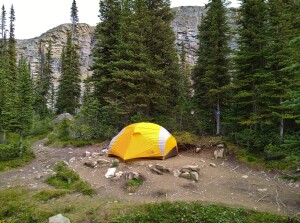 Permitted camping at designated trail camp.
Permitted camping at designated trail camp.
Happy Trails!
Permits in hand, those trail camps with their good tent pads, water sources, and other amenities, are something to look forward to. One less thing to think about while hiking, keeping the experience most enjoyable.

